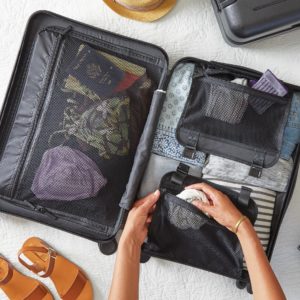Planes, Trains, and Spinal Discomfort: Strategies for Protecting Your Back
 Got a road trip or flight planned? Sitting in the same position for extended periods can cause a number of back problems including muscle strain. Not only that, handling and lifting luggage is also part and parcel for the season, and while most of us are in a rush to get it over with, doing so puts us at risk.
Got a road trip or flight planned? Sitting in the same position for extended periods can cause a number of back problems including muscle strain. Not only that, handling and lifting luggage is also part and parcel for the season, and while most of us are in a rush to get it over with, doing so puts us at risk.
Last month we discussed how to protect your spine from your day-to-day activities at work. Let’s take a look now at reducing the stress on your back over the course of the travel-filled holiday season.
Use Protective Lifting Techniques for Luggage
If the “heavy lifting” falls to you in your family, or if you are traveling alone, you may already now after the Thanksgiving season just how much stress lifting luggage can actually be. Especially for those over 40, repetitive lifting is one of the biggest risk factors for spinal injury. Here are our tips for making sure you don’t cause yourself undue strain:
- The old adage is 100% true: don’t bend at the waist, and lift with your legs!
- Try to keep your feet flat when lifting, to avoid putting pressure on your knees
- Make sure weight is distributed evenly across both shoulders, and not dragging down one side of your body
- When carrying something for long periods, keep it close to your center of mass
- The closer you are to something when you start lifting it, the less stress it will be for your muscles and spine
- Slow, careful movement is better overall. We all know how to pick something off the ground, but proper lifting and carrying can help make the travel experience less of an ordeal for the designated lifters of the family.
Pack Light
Bulky suitcases are bad news for your back. Try to have at least one suitcase with wheels per person, and when lifting it into an overhead compartment or trunk, lift from the bottom of the suitcase.
That leather suitcase that you want to show off may also be better suited for short business trips, not a family excursion. Lighter materials, like cloth or vinyl, may be your best bet for those longer travel itineraries.
Maintain Good Posture

Just like we have mentioned before, vigilance is key when maintaining good posture. Travel is never easy, and the stress can cause us to slouch, and do so for long periods. As always, periodically check your posture so that:
- Your weight is displaced on the outside of your feet
- Your lower back has proper lumbar support
- Your shoulders are back, your head is level, and your thoracic spine is straight
- Your headrest is not pushing your head forward, but supporting the middle head
For drivers: adjust the steering wheel and car seat to avoid slouching or moving away from the seat’s support. Raise your rearview mirror – it will force you to sit up straighter. Use cruise control when possible as well. If you are on a flight, adjust the seat as much as possible and bring extra support for the lower back, neck, and feet if recommended by your chiropractor.
Seat Adjustments to Improve Back Support
Trains, planes, buses, and cars often allow you to adjust and customize the seating to meet your build and body type. However, consider bringing along some extra support in the event that it’s not enough to support good posture.
- Lumbar support. Most seating, commercial or even in your own car, lacks good enough support for your lower back to stay curved over long periods. A lumbar pillow can be placed behind the lower back to maintain healthy posture and help avoid those painful strains when standing up after the drive or flight.
- Neck alignment. You can purchase a “U-shaped” neck pillow in most airports or rest stops, even sometimes at dollar stores. These are critical if you plan on napping during a car ride, train ride, or flight, as they help keep your neck from straining one side or the other.
- Footrests. Your proper posture starts at the feet! Both feet should be flat on the floor and the knees and hips bent ninety degrees for passengers. Drivers are best served using cruise control and only keeping one foot forward on the gas pedal.
Move as Much as Possible
Your spine, just like the rest of your body, was designed to be mobile. Therefore, it makes sense that you need to get up and stretch if you want to keep from a sore, strained back.
- Getting up and walking every hour or so keeps the muscles and joints active, preventing stress from building up in the lower back and hips. If you’re not traveling commercially, you can get a similar routine going every two hours. Even if it feels like a bit much to stop the trip so frequently, keep in mind that it’s not unheard of especially if you’re traveling with family or pets – bathroom breaks are a good excuse to get out and walk around too, and only slow down your trip by five minutes at most.
- Hamstring stretches are important! Check out our hamstring stretch to keep the blood flowing, prevent cramps, and reinforce good posture. Try to stretch every thirty minutes if possible.
- Neck stretches should be done every hour, and the proper technique can also be found on our blog.
Not only will all of this prevent stress on your joints and spine, staying active on a long travel day has the benefit of keeping you alert and energized. Make stretching and spine health a part of your travel plans!
